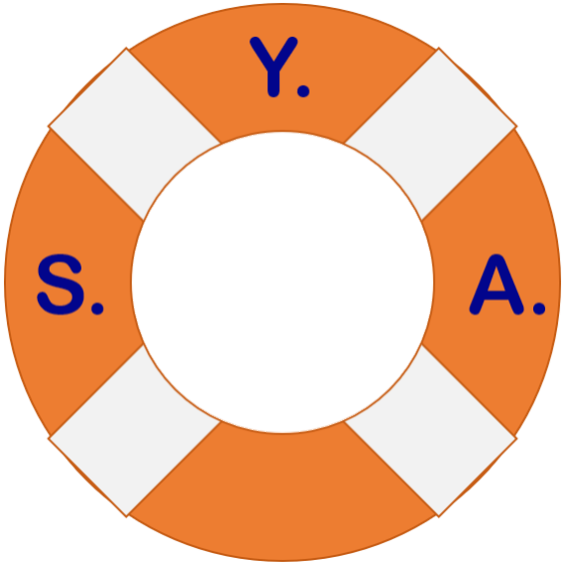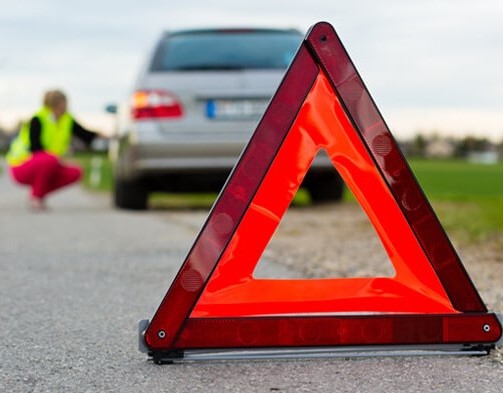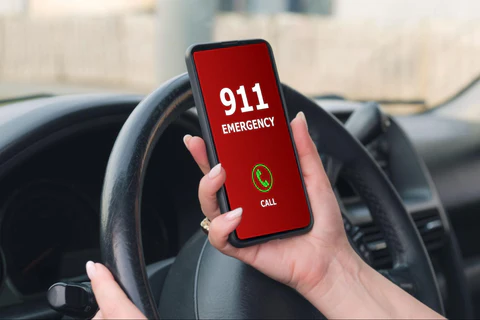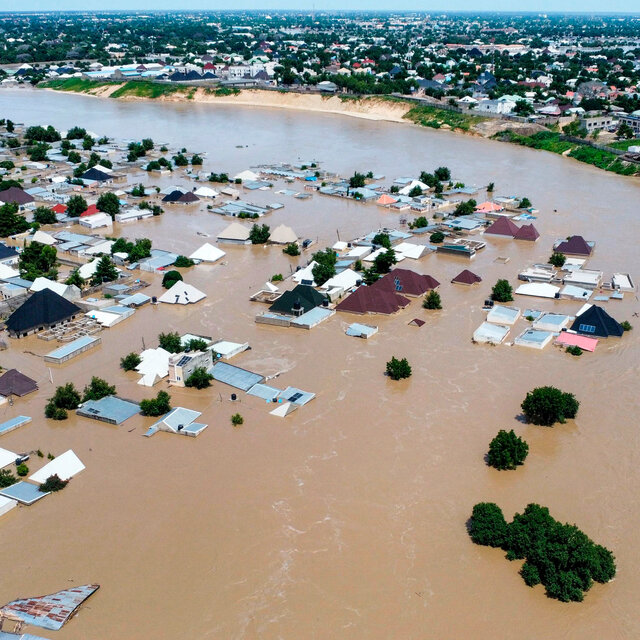Having a car emergency kit is essential, yet the majority of Americans don’t have one. So, to help those of you that do not, this week I want to cover what is in mine.
It all started when….
Before getting to the details, I want to share my journey and how I got to the point I’m at today. My story begins back in my early 20’s when I was stationed in Utah with the Air Force. I was driving an ’87 Ford Thunderbird Turbo Coupe at the time. I loved that car. It was the most totally inappropriate vehicle for my lifestyle at the time: The single life that included driving into the mountains year-round for camping, backpacking, skiing, etc. with this turbo-charged, rear wheel drive, 2-door family sedan.

If Ford could have seen the places I took this car they would have been absolutely amazed and horrified at the same time. I drove this car not only in Utah, but across the US numerous times. I took it to Germany and drove it on the Autobahn for 3 years before returning the US with it. Despite the abuse I put it through, it handled it well with very few major issues over the 12 years I drove it. As with any vehicle, most issues occurred towards the end of my time with it.
But I digress.
The Road Trip
I had just turned 21 and my parents and brother came for a visit that summer. I had decided to take them on a short road-trip to the Utah/Nevada border town of Wendover and check out a casino. It was about a 2.5 hour drive on I-80 one way and anyone who has driven that stretch of highway west of Salt Lake City knows there is NOTHING out there until you get to Wendover.
My brother being the bored, mischievous teen that he was (and still is in his 40s) was digging around the pocket in the back of the passenger seat. This is where I had put a collection of highway maps (this was way before GPS and cell phones), an Aircrew Survival Manual from an F-16 fighter jet (part of the survival kit in the ejection seat) and this emergency car guide I got from American Express.




The AMEX Guide
My brother started reading the American Express guide to himself but before long he had to read some of scenarios and recommended actions aloud to the rest of us. It didn’t take long before all of us were in hysterics. I’m not sure how I did not wreck the car I was laughing so hard. With tears streaming down my face, my sides ached as did everyone else’s.
While I’m sure the authors had good intentions when writing this guide (some of the advice was solid) much of what was in the book was laughable. From intentionally side swiping guardrails, poles and trees to slow down if your brakes were out to the list of “trunk tools” you were supposed to keep in your vehicle at all times.
Written for earlier cars
I imagine at the time this was written they were basing the recommendations on driving a steel tank that most cars were before the mid/late 80s. Back then there were no crunch zones that are standard today. Everything was steel including the bumpers. Cars were heavier and more rigid. They would have needed to hit solid objects to try to slow down or stop in the event of brake failure. Today’s cars are designed to crumple to absorb the energy and protect occupants during impact.
As I mentioned, my family and I we were in hysterics for almost the entire drive there and back. Besides questionable actions, the amount of tools and spare parts that were “recommended” to be in your “trunk” would have taken small trailer to haul around along with an auto mechanic to use them. I am not exaggerating. I assume this also speaks to the lack of quality and unreliability of cars manufactured in the 70s and early 80s before American manufacturing adopted processes already in use by their Japanese counterparts.
A realistic emergency kit
Suffice to say I did not follow those recommendations exactly as written but did come to realize that with how desolate this stretch of road was it would be a good idea to have some basics in the car in case of emergency.
Along with the mini-spare, jack and lug wrench I threw in a lightweight wool blanket, old military issue folding shovel and jumper cables in the trunk. I also added a small flashlight, tire pressure gauge and some Band-Aids in the center console.

Secret road-trip
I thought I was good to go, but then I did something really dumb. It was sometime in late March or early April the next year. After working a night shift and getting off work at 8am, instead of heading back to my dorm to sleep, I decided to check out a campground I had heard about.
I left right from work, still in my military fatigues. I didn’t tell anyone I was going, let alone where I was going. It was still on the colder side and fortunately I was wearing my field jacket with a wool liner in it. As I worked my way up this winding gravel/dirt road on the mountain, I came around this corner to a portion of the road that still had snow on it. I could see two sets of tracks in the snow. The set on the left were not very deep. The set to the right was very deep and eventually merged with the set on the left further up the road. I paused briefly but decided I would try it using the left set of tracks since the snow was only covering about 100-150 feet of the road that was shaded from the sun.
Slip sliding away…
Now remember at the beginning of this article I mentioned this was a rear-wheel drive car? Did I mention that I’m on a slight incline going up this mountain? Needless to say, I did not get very far and quickly realized that I was not going to be able to make up these icy tracks.
I stopped, put the car in reverse and expected to just back down the tracks to the gravel/dirt road about 50ft back. Unfortunately, the ice and gravity had a different plan for me. As I was backing up, the car slid into the other, deeper set of tracks at the merge point. My car slid backwards until it came to a stop. No amount of spinning my wheels was going help. I was stuck.
Thankfully the way I slid was towards the mountain and not the edge or I probably wouldn’t be here to tell this story. As I get out of the car to assess the situation, it hits me that nobody knows I’m up here. Remember this is around 1991 and cell phones are not a thing yet. If I had to, I could walk down the mountain, but I only need to go about 30 more feet to be out of the snow.
I also realize that when my car slipped into the other tracks and slid backwards, that it lifted the car off the ground. My tires were not even making contact, they were just hanging like they would if on a lift in a garage.
Time to dig out
Thankfully I put that shovel in my trunk last year. I get it out and start knocking down the block of snow that is in between the tire tracks. I do this all the way back to the gravel road so that the snow is only about 6″ high compared to the 18-24″ it was. My car should be able to back down over it. Before that can happen though, I need to dig the snow out from around and under my car. I start around the sides of the car so I can get to the snow underneath. After that, I had to lay on my back under the rear of the car to work on the snow there, scooping away at this block of snow between the tires that my car is resting on.
As I made progress, the car would periodically shift as the weight of it pushed down on the remaining snow that I was removing. I had to be careful not to get trapped under the car since I had nothing to place by the wheels to keep the car from slipping backwards. Gravity continued to work and pull the car down as the height of the block of snow decreased from my digging.
While I was doing this another car came up the road and saw me, but never even stopped to ask if I was ok or needed help. I don’t know if they thought I was dead under the car or what but they just backed up and left without saying a word. It was unbelievable and I was pretty pissed. It made me more determined to get out of this. I had been up here for a couple hours at this point and was exerting myself enough that I was staying warm, albeit very sweaty. I had no food or water with me and was getting hungry and thirsty on top of being exhausted from working all night.
Free at last
Finally, after the car dropped enough that I could see the tires were on the ground again, I decided to try to backup. At first, I still spun my tires, but then I used the tried-and-true rock back and forth method and was able to get enough momentum to break the last bit of resistance from the snow and was successful at backing up to the gravel.
My jacket was soaked, outside from laying in the snow and inside from sweating profusely. After getting my car turned around (had to do something like a 50-point turn on this narrow section of the road), I stopped and removed my jacket so that the heat from the car could keep me warm and start to dry off.
Only then did I realize how cold my feet were from being outside and not having proper snow boots on. They managed to warm up on the drive home, but it was not lost on me how lucky I was that I got out of that unscathed. There are so many other ways that could have played out and none of them good. After this, when I travelled, I included food, water, and other supplies in case I broke down in the middle of nowhere and made sure someone knew where I was going.
Wilkomen auf Deutschland
When I got to Germany in 1992, I had to get my International Driver’s license to be able to drive on their roads. There were some requirements including that you were certified in basic first-aid and purchased an approved warning triangle and first-aid kit that had to be in the car at all times.

This was due to the high speeds on the Autobahn which had much fewer on/off ramps along your route. Accidents, while fewer in number, when the did occur, usually involved a larger number of cars that could shut down the Autobahn in one or both directions for hours.
Stuck in a Stau
The German word for traffic jams is ‘stau’ and I got caught in many of them over the 3 years I lived there. Unlike impatient, always rushing Americans, Germans took these delays in stride. Many had food and drink with them and, if an extended delay was likely, would exit their vehicle and go have a picnic on the side of the road while they waited. People would chat, kids and dogs would play in the grass. They just made the best of it because many had prepared for this eventuality by having an emergency kit of sorts to pass the time.
One interesting fact was that you were required by law to render aid or assistance if you witnessed an accident. Unlike in America where most people flee the scene or don’t want to get involved, you could be arrested and charged if you left the scene of an accident even as a bystander. Especially if people ended up dying and you did nothing to try to prevent it. On the flipside if you at least tried to render assistance, regardless of the outcome, you were not accountable. (Unless there was proof of gross negligence or willful harm done to any of the victims).
Back to the US
When I returned to the US in the fall of 1995, I was stationed down near St. Louis. It was here I started to experience more mechanical issues with my now 8-year-old car. In the summers of 1996 and 1997 I had a tire blowout on the highway and had to put on the mini-spare. Both times I was on I-70 in the middle of nowhere. It became clear I needed to have a few more things in the trunk than I had. Fortunately, in both cases, I was able to change the flat and get on my way again.
Cell phones become a thing
In the spring of 1997, I got my first cell phone. I can’t even remember the brand, but I remember how excited I was to have a phone that went where I went. If service was available that is. The networks were not as widespread as they are today. The phone was also very basic compared to smartphones today, but at least I had more of a lifeline while on the road.
Eight months later, I moved back to the suburbs of Chicago. The following year I upgraded my cell phone to the first of several Nokia phones everybody had back then.

New SUV and more stuff in the kit
I now lived in a heavily populated area where a breakdown would not be a major issue in terms of getting help. After selling the Thunderbird in 1999, I bought a new SUV, a 2000 Nissan Xterra SE 4×4. It would be traded in for a 2002 Xterra SE Supercharged 4×4 model 3 years later. I took every opportunity to test the 4×4 off-road capability on both of these. Getting out of town was a lot of fun, making several cross-country road trips to Utah in winter and summer. I also made trips to Texas, South Carolina and up into Canada to Toronto and Niagara Falls.
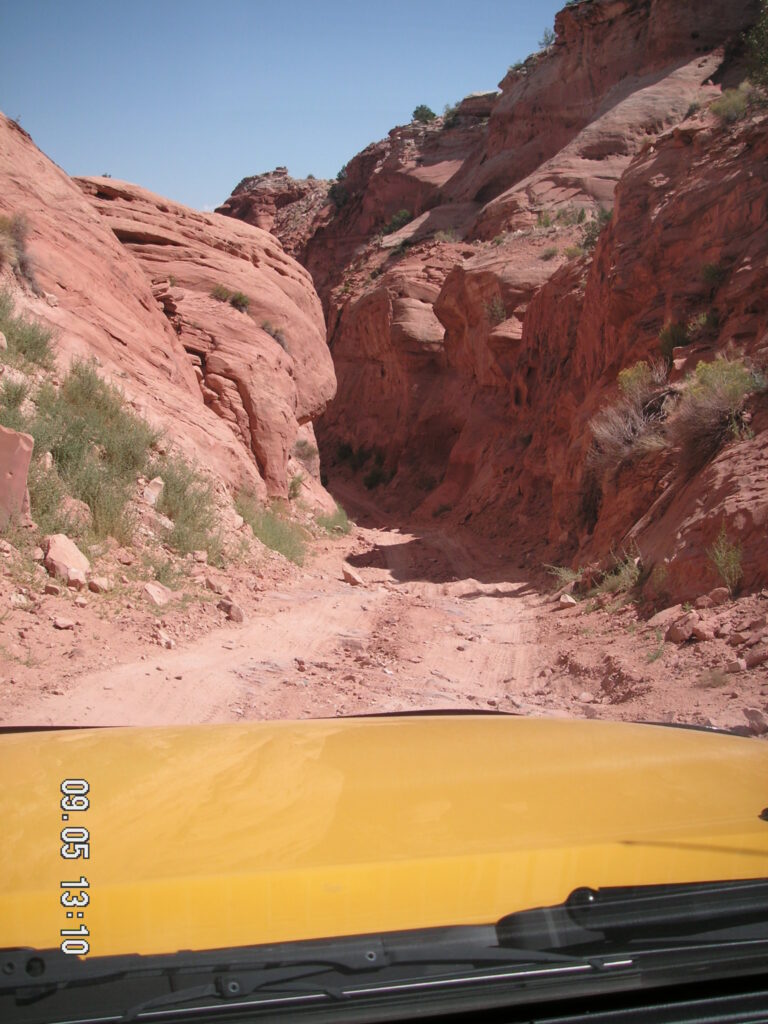
This meant the possibility of getting stuck in mud or snow, crashing into a tree or bottoming out on rocks. As a result, in addition to the items previously mentioned, I added:
A heavy-duty tow strap

Rechargeable spotlight (no longer have this)
100′ of 5/8″ thick rope

Headlamp
Buck-knife

Collapsible snow shovel (replaced the old military shovel)
Heavy-duty moving pad

Hi-vis safety vest

A box of tissues (allergies)
First-aid kit
The Xterra even came with a nicely stocked first-aid kit in the rear door.

Paying it forward
These additional items served me well. Especially the tow strap, which I used to pull vehicles out of the snow if they slid off-road or were stuck. I would actually go out in heavy snowstorms purposefully looking for stranded motorists to help out. Partly because I was a big kid and enjoyed seeing what my SUV could handle, but also because of my experience on the mountain a decade before. Like me back then, most of the people I helped had no emergency kit or supplies in their vehicle. My experience has shown that most people don’t do any sort of “What if…?” thought exercises to help be prepared when something does go wrong.
Today
Fast forward 20 more years and I am now living back in Utah. I have a much more comprehensive car emergency kit. I love travelling to state and national parks. While many of these are in remote areas, I don’t worry about it. Between modern cell phones, GPS apps and around a half million miles under my belt, I am so much more prepared if I break down or am involved in an accident these days than ever before.
My Car Emergency Kit
So what do I keep in my car’s emergency kit? Well for starters I’m now driving a 2013 Hyundai Elantra which isn’t going off-road (at least not on purpose). It just hit 90,000 miles and although I’m not driving as much with the pandemic still going, it has the following items in it:
Car Items
Fix-a-flat kit
This replaced the spare tire in 2013 model year of my car. From what I know they went back to a mini spare in subsequent years. It includes sealant and 12 volt air compressor.

With this kit there is no spare tire, no jack or lug wrench. The idea is that you inject the sealant into the tire via the fill valve. Then use the air compressor to refill the tire. No jack or lug wrench needed. I’m not so sure about this system. Fortunately, I have never had to try it out.
Tow hook (removable)

Flat-head Screwdriver

Jumper cables

Tire Pressure Gauge

Electric Flashing Road Flares (2-pack)

Survival / Bugout items
Umbrella

Heavy-duty reinforced plastic IKEA shopping bag

Fabric grocery style bag

Lightweight wool blankets (x2)

Small 2-string Backpack/Bag
This can hold everything on the list below if it becomes necessary to leave the car.

Emergency contact information sheet (printed out)
This is a screenshot of the blank form but rest assured mine is filled out.
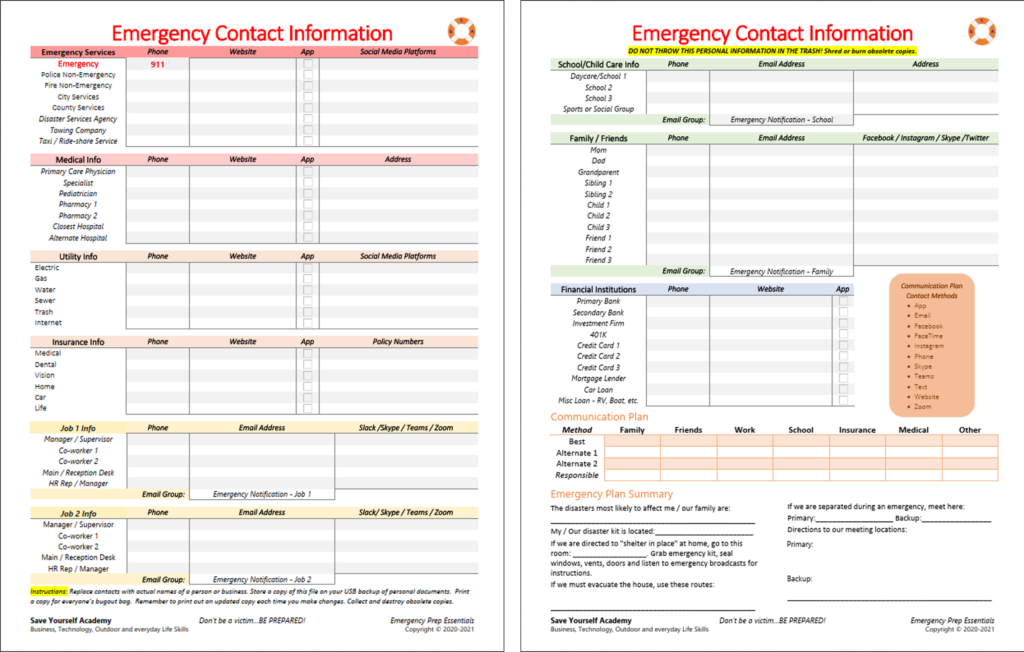
Cell phone charging cable w/plug

Duct tape

Multipurpose utility tool
This is a cheaper Amazon Basics version of a Leatherman. I have one in my bugout bag as well.

Headlamp
I check the 3-AAA batteries every 6 months.
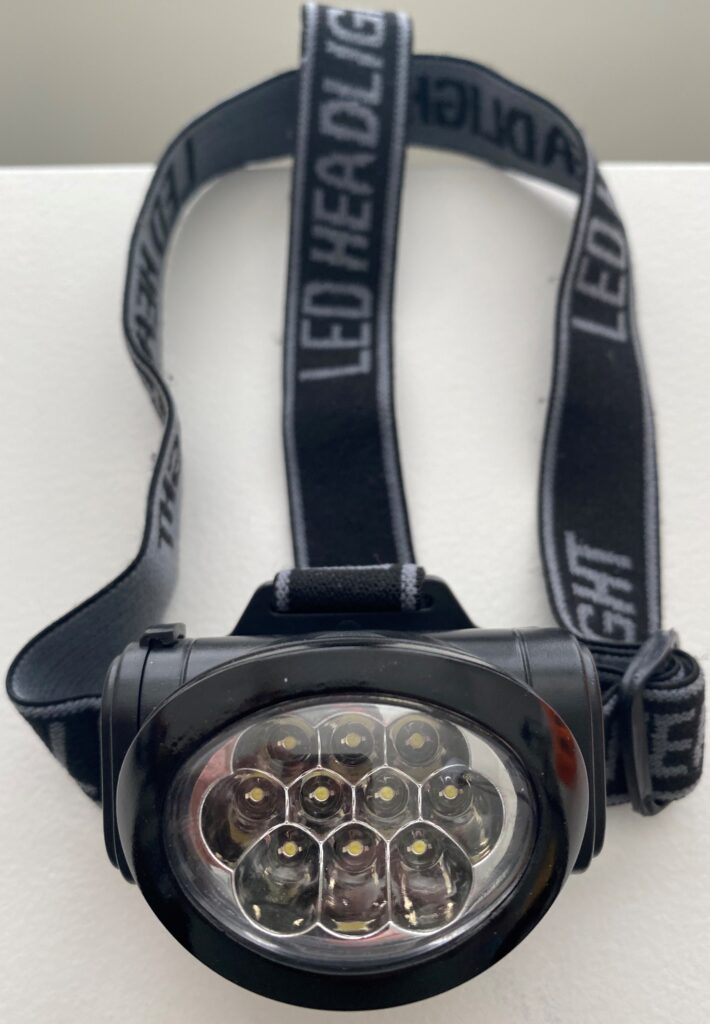
Hand-crank flashlight (x2) (no batteries needed)

Rain poncho (x2)

Emergency Whistle (x2)

Emergency Blanket (x2)

Basic First aid kit

- Gauze
- Flexible self-sticking wrap
- First-aid tape
- Bandages (assorted)
- Antibiotic ointment / Neosporin
- Anti-Itch cream
- Aluminum padded splint
- Ibuprofen
Bungie cords w/ carbineers

Ratchet straps (x2)

Winter Additions (Oct-Mar)
Car Items
Extra -20F Washer Fluid

Snowbrush

Ice Scraper

Survival / Bugout items
Aluminum Collapsible Shovel

Extra Winter Hat

Extra Winter Gloves

Wrap-Up
So, there you have it. Most of the items listed sit in a storage compartment under the trunk bed in place of the spare tire. I hope you enjoyed my journey and how I came to carry the items I have in my car. I really enjoyed the trip down memory lane. Anytime I’m leaving the house for more than local errands in town I also bring with me a filled 24 oz insulated water bottle and some trail snacks, just in case.

Comments / Questions
If you have any comments feel free to share them below. If you have any questions as to why I have something or don’t have something in my kit, please ask.
Last Updated on August 30, 2022
